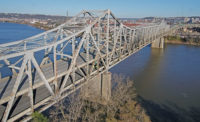As the Biden administration continues rolling out funding provided in the $1-trillion Infrastructure Investment and Jobs Act (IIJA), the U.S. Dept. of Transportation released the first year's installment of a new $26.5-billion program to replace and rebuild aging bridges around the country.
The DOT action, announced on Jan. 14, allocates $5.3 billion in fiscal 2022 funding for the program, using a formula based on each state's estimated costs to upgrade or rehabilitate bridges that are rated in poor or fair condition. In addition, $165 million is set aside for use by indigenous tribes.
[View Federal Highway Administration state-by-state funding allocation here.]
In a Jan. 13 background briefing for reporters, a senior Biden administration official said the new program represents “the largest investment in bridges since the creation of the Interstate Highway System.”
Another administration official said, “This money is needed to address the 43,000 bridges across our country that are in poor condition." The official added that the program is expected to upgrade as many as 15,000 bridges nationwide.
California will receive the largest allotment of the 2022 bridge formula funding, with $849.4 million. New York ranks second, set to receive $378.4 million, followed by Pennsylvania, receiving $327.2 million; Illinois at $274.8 million; and New Jersey, gaining $229.4 million.
Twenty states plus the District of Columbia and Puerto Rico each will receive the minimum allocation of $45 million.
Looking at the five-year funding total, the top five states are the same. California's allocation is $4.2 billion; followed by New York, to receive $1.9 billion; Pennsylvania, $1.6 billion; Illinois, $1.4 billion; and New Jersey, $1.15 billion.
New 'Off-System' Bridges Set-Aside
In a particularly creative wrinkle, the program requires states to use at least 15% of the new money to rehabilitate or build smaller bridges that are not part of the National Highway System, which includes the Interstates and other major arterials.
The lure of the new provision for such "off-system" bridges, including those owned by counties, cities or towns, is that those projects will be 100% federally funded—a significant departure from the traditional system, in which states generally must contribute a 20% share of federal-aid bridge and highway project costs.
Clarence Anthony, National League of Cities CEO and executive director, said of the off-system set-aside, "This is simply amazing news for smaller rural communities, places that have been hit hard economically."
Speaking at a joint briefing with the American Society of Civil Engineers (ASCE), he added, "This is the right time, the right policy to fix the bridges that really need it."
Maria Lehman, ASCE president-elect and director of U.S. infrastructure at engineer GHD, said states and localities have had transportation plans in place and added that some projects have also gone through the preliminary design stage.
"I'm hopeful that in many parts of the country, you're going to start seeing orange cones all over the place this summer," she added.






